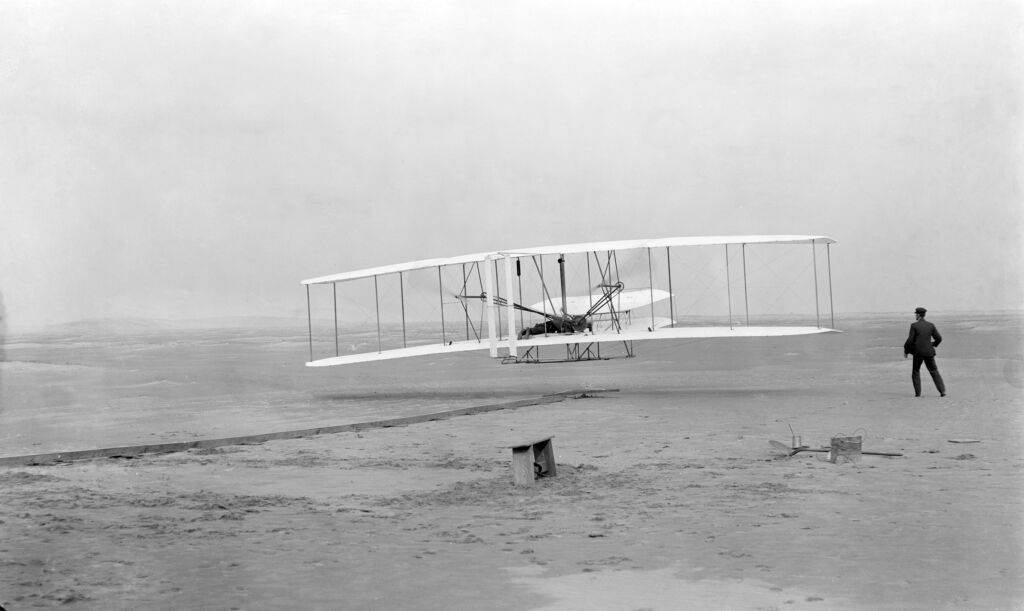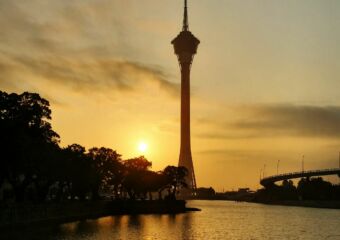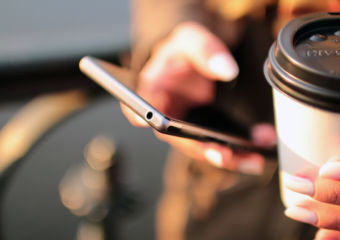Featured image: Wright Brothers’ first flight on December 17, 1903 (USA). Source: Wikipedia
Nowadays, planes might be quite an ordinary thing. However, there was a time when skies were, indeed, the limit. With the help of a well-documented book that explores the history of aviation in Macau–by Luís Andrade de Sá–we take you on a journey of arrivals and departures to and from Macau! Read on and find some cool facts and curiosities about the history of this transportation and more.
The Wright Brothers were the first ones to ever fly a plane into the skies. The achievement took place on December 17, 1908, at a North Carolina (USA) beach. Well, there were, of course, countless (unsuccessful) tries before this one, a bit all over the world, mainly the US and Europe. The siblings managed a bicycle factory in Dayton, Ohio, and had aeronautics as a beloved hobby; the goal was to build a motor valve airplane that was “heavier than the air”. They even started making gliders at the factory in 1899 and a few years later, they were already having some successful experiments flying gliders in Kitty Hawk, the area where they later did the world’s first-ever flight. On that December day, they rose 37 meters from the ground at an average speed of 48km per hour. They flew countless times more, boosting interest and love for airplanes and motors all over the world, including Brazil, France, and other countries. Soon enough, everyone wanted to know more about these “motor birds” and goals became more and more challenging. From a few meters to kilometers, from one city to the other, between neighboring countries, then continents, seas, and so on. On June 15, 1919, British pilots John Alcock e Arthur Whitten-Brown successfully departed from Canada and arrived in Ireland–unfortunately crashing–after a 16-hour journey across the ocean.

Thomas Baldwin on one of the first airplanes, 19th century. Source: Website of the Civil Aviation Authority of Macau
High in Macau
Although we’re telling you the story of aviation, we feel we have to go back a bit to the first-ever happening involving air and acrobatics, with yet another set of siblings. The Baldwin Brothers–and we’re not talking about the actors–were keen on stunts, especially in the air, and on entertaining the public. One of the coolest stunts was a free fall jump from a hot air balloon in central Macau, in 1891.
The next great achievement in Macau aviation history can be attributed to Frenchman Charles Ricou, an experienced pilot who served as such in the First World War. He was born in Hong Kong and grew up in France, where he took flying classes to later embark on the war. Ricou became a Macau resident at the start of the 20th century. Besides being a shareholder of the Far East Electric Company–the only electricity provider company in the region–between 1906 and 1910, he also owned an ice company, Macao Ice and Cold Storage Company. This then opened doors to what follows: Ricou felt the need to transport goods and passengers between Macau, Hong Kong, and Guangdong. After the government’s approval, the former pilot successfully started The Macao Aerial Transport Co. Ltd and built a temporary hangar for hydroplanes situated in the Inner Harbour, Barra area. They did a test on February 3, 1920, that took 20 minutes–Macau/Hong Kong–compared to the 4.5 hours that a steamboat took.
Ricou started by purchasing five Curtiss Model F hydroplanes for Macao Aerial Transport, which provided private flights for entertainment and public transport of passengers and mail between Macau and other regions close by. According to the Civil Aviation Authority, the company was closed in 1922.
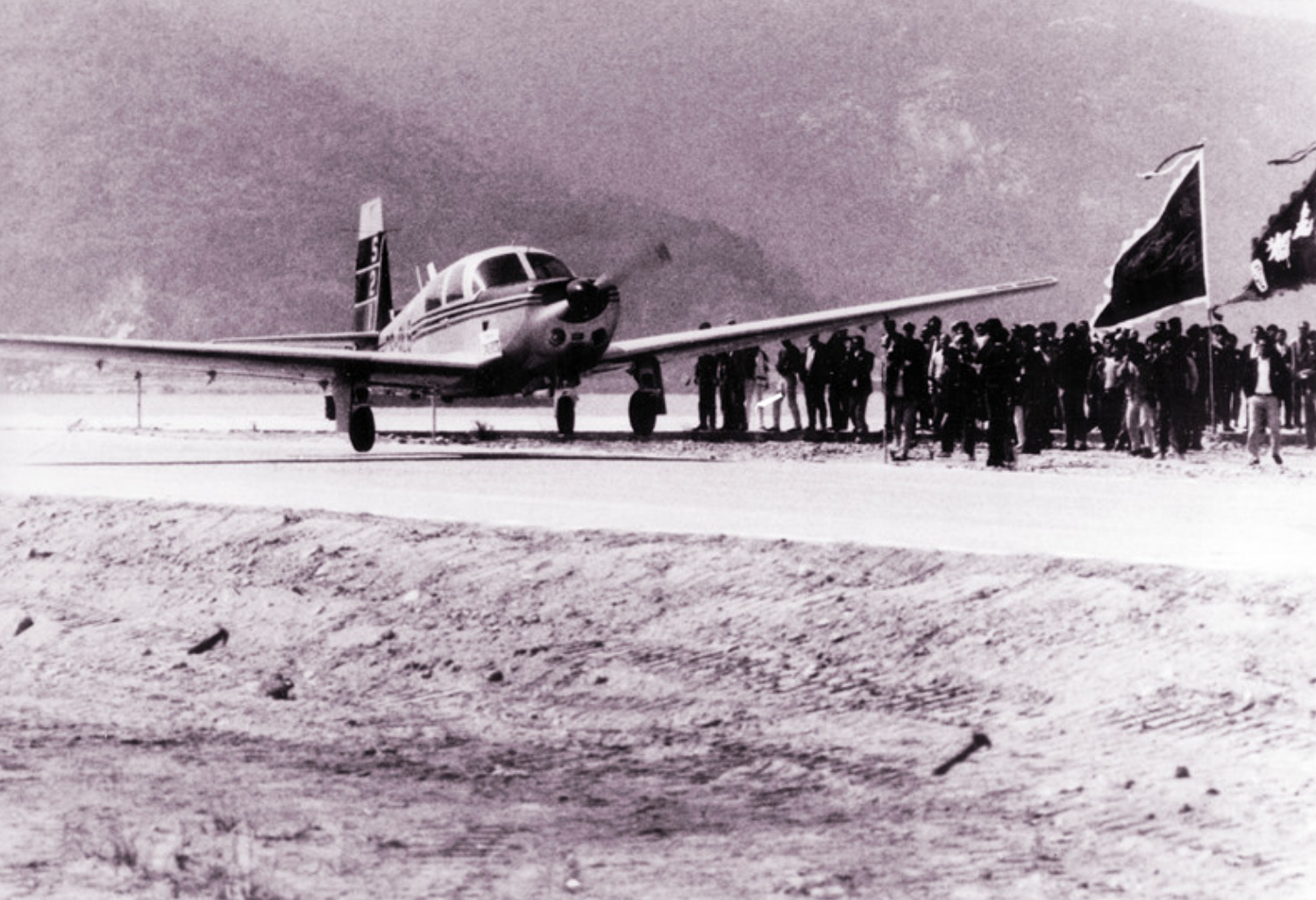
Portuguese aircraft Sagres landing in Coloane Macau from Lisbon (February 1987). Source: Website of the Civil Aviation Authority of Macao
Between 1921 and 1922, Portuguese pilots did several attempts at cross-border flights. Gago Coutinho and Sacadura Cabral performed the first-ever aerial crossing of the South Atlantic ocean (March–June 1922). Later, Brito Pais and Sarmento de Beires started concocting the first flight from Lisbon to India–which they envisioned would culminate on the first Portuguese air journey across the world. Instead of India, they lengthened the trip to head to Macau. Being so, Brito Pais, Sarmento de Beires, and Manuel Gouveia made history by flying “Pátria” (translated into Motherland)–the plane was named after a verse on Camões’ Lusíadas–from Lisbon to the south of China. Although failing the goal of successfully landing in Macau, this is a paramount event in the history of aviation.
Nowadays, we expect a flight from Portugal to Hong Kong to take around 16 hours. Back then, these took months. This journey from Portugal to Macau took countless stops for gas, rest, and repairs, two aircrafts, and a four-month journey by air (April 17–July 20, 1924, of the same year), with an unsuccessful landing on Chinese territory very close to Hong Kong.
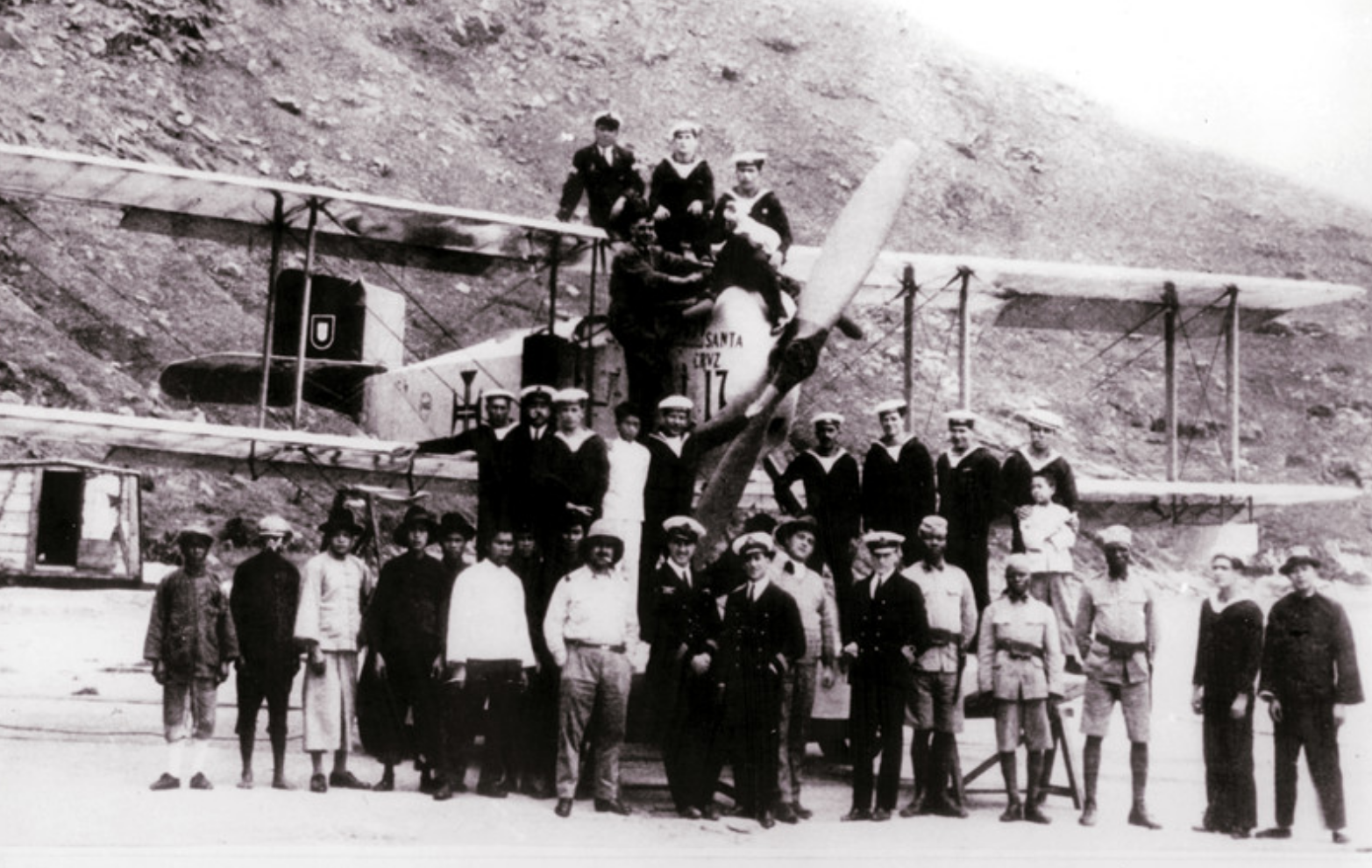
The Macao Naval Aviation Centre team with a Fairey aircraft (1929). Source: Civil Aviation Authority of Macau
The Macao Naval Aviation Centre
Macau’s first naval aviation base–part of Portugal’s network as the region was understood as part of the empire–was created at the end of the 1920s. Its main task was to check and monitor the activity around Macau, namely sea pirates. It’s interesting to know that in 1927, Portugal only had three aviation centers under its wing, which made Macau’s the third and only one outside the country. In 1945–as a consequence of the Second World War–the station was bombarded by airplanes of foreign forces.
Although there had been an attempt to start an aviation school a few years before–it had six students and only two completed the course–the Macao Naval Aviation Centre (Centro de Aviação Naval) was established in 1939 aiming to train pilots, mechanics, radiotelegraphy specialists and other kinds of technicians.
That time Pan Am chose Macau
Macau is often seen as a place of passage, even in the early 15th and 16th centuries, when the city was seen as the door to China and neighboring regions. This was also the case in 1937 when Pan Am opted to have Macau as a mid-stop on their San Francisco-Honolulu-Manila-China route. This literally put Macau on the international map, with thousands of passengers, from all over the world, stopping here. First, they used Clipper planes and then Boeings. The huge US Pan American World Airways was founded in the 1920s and featured frequent flights between Key West, Florida, Havana, and Cuba. The company collapsed in 1991.
MATCO and Miss Macau
This was only the start of great flights to and from Macau! In 1948, the Macau Air Transport Company (MATCO)–Macau’s first-ever airline–was founded. It was Macau entrepreneur Pedro José Lobo, who after discussing the idea with Roy Farrell and Sydney de Kantzow (from Cathay Pacific), decided to start this airline. The first route they established was Macau-Hong Kong. Since these flights took around 20 minutes, they were known as “cigarette flights”, the time it took to smoke one.
A subsidiary of the Hong Kong giant, it was responsible for flights between Macau, Hong Kong, Saigon (now Ho Chi Minh), Bangkok, and Borneo, thus covering a huge part of different Southeast Asia territories.
There were two Consolidated PBY Catalina seaplanes doing these routes, departing from an old ramp in the Outer Harbour Ferry Terminal toward Hong Kong’s old airport, Kai Tak. The airline ceased operations in 1961.
MATCO was also involved in what’s now recorded as the first-ever hijacking of a commercial aircraft, inscribed of the Guinness World Records for posterity. En route from Hong Kong to Macau, Catalina aircraft Miss Macao was highjacked midway and crashed. It resulted in the death of 26 people, including passengers and crew. According to statements from police commissioner Paletti, some of the passengers were millionaires and transported HKD $500,000 onboard. The only survivor was one of the robbers, who revealed his plan: to hide inside the plane, take control of it and rob the passengers to then land somewhere and request a ransom.
Also read: From Michael Jackson’s Glove to Bungee Jumping: Macau Guinness World Records

Portuguese aircraft Sagres landing in Coloane from Lisbon (February 1987). Source: Website of the Civil Aviation Authority of Macao
Sagres for the win
With people getting more and more eager to explore the skies, plane trips started getting less time-consuming and dangerous. It was the 1980s and several cities around the world were already equipped with airports, some bigger than others. Macau didn’t have one but was still the object of fascination for lots of people, especially the Portuguese. Being so, pilots Jorge Cruz Galego, Arnaldo Alves Leal, and Álvaro M. Prata Mendes decided to embark on yet another try departing from Lisbon towards Macau in January 1987. This time, the flight was incredibly successful and took way less time when compared to the 1924 attempt. After 27 days, thousands of kilometers, and 23 stops, the aircraft named Sagres, landed on a landfill in Coloane on February 6, 1987.
The local government had a golden plaque done to commemorate this achievement, and it unveiled it beside the one from the previous landing of 1924, in the Leal Senado Building. Unfortunately, on its way back to Portugal–February 15–and after experiencing terrible winds and lack of fuel, the aircraft crashed in Luxi, China. If you often go to Seac Pai Van Park, you must’ve wondered what’s that old plane doing by the entrance. Well, now you know: it’s the remains of Sagres, the same aircraft that flew from Lisbon all the way to Macau in the 1980s!
After the aircraft came the helicopters, way smaller and easier to land because heliports can be located at a building’s rooftop or a smaller landfill. Although established in 1988, it wasn’t until the end of 1990 that East Asia Airlines Limited started operating helicopter flights between Macau and Hong Kong. The company is still in operation–it was rebranded to Sky Shuttle Helicopters Limited in 2008–and provides the SkyShuttle helicopter rides, departing and landing at the ferry terminal. This might as well have been a rehearsal to launch Air Macau (Company Limited). Founded in November 1995, Macau’s own airline provides international flights and focuses on China, Southeast Asia, and Japan.
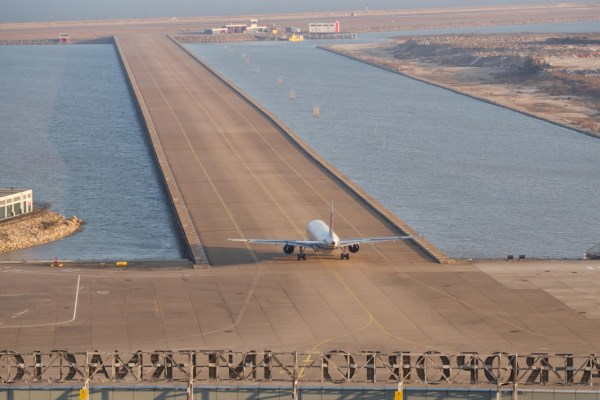
Macau International Airport landing strip. Source: Wikipedia
Macau International Airport: The Grand Plan
The idea of having an airport was always a goal since the 1950s. Almost every Portuguese governor had included it in their plans, feeding the population with hopes of an airport in a near future. However, the idea only became feasible several decades after.
In January 1989, Sociedade do Aeroporto Internacional de Macau S.A.R.L. (CAM) was founded. Created with the ultimate goal of erecting an airport in Macau, it took about five years to complete it. The Macau International Airport was finally inaugurated in 1995. Continuous delays for lack of materials and other issues resulted in a change of plans: the landing strip was to be built on an artificial island (constructed on top of landfills) and measurements were made considering the largest aircraft at the time, Boeing 747-400. The artificial island includes around 95% of the whole airport structure and the construction cost 8,000 million patacas.
Although Macau has its own airport, flights from Europe, the Americas, and Oceania usually land in Hong Kong, not here. However, for a very short period, the Macau International Airport, had, indeed, a connection to Europe. In 1996, along with a Belgian company, Portuguese airline TAP established the “Orient Route”, which operated two weekly flights between Lisbon and Macau with a stopover in Brussels. Soon after they started, the Belgian company withdrew from the deal, and TAP started operating on its own, now with a stopover in Bangkok. Unfortunately and due to incredible financial losses, the Orient Route reached an end in 1998.
Macau International Airport Avenida Wai Long, Taipa, +853 2886 1111, www.macau-airport.com/en

